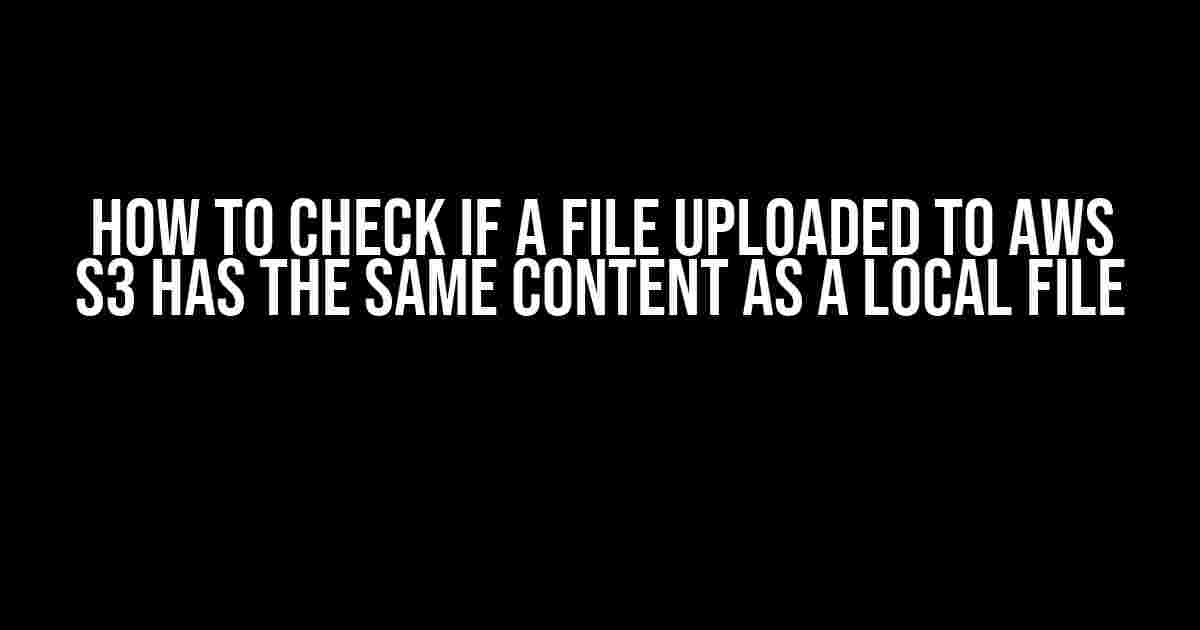AWS S3 is a fantastic way to store and manage your files, but have you ever wondered how to verify that the file you uploaded matches the one on your local machine? It’s essential to ensure data integrity, especially when working with critical files. In this article, we’ll take you on a step-by-step journey to compare the contents of a file uploaded to AWS S3 with a local file.
Why Compare File Contents?
Verifying file contents is crucial in various scenarios:
- **Data Integrity**: Ensuring that the uploaded file is identical to the original file on your local machine.
- **Version Control**: Verifying that the correct version of a file is uploaded to S3.
- **Security**: Detecting any unauthorized changes or tampering with the file during upload.
- **Troubleshooting**: Identifying issues with file uploads or downloads.
Prerequisites
Before we dive into the comparison process, make sure you have:
- AWS S3 bucket and the necessary credentials (Access Key ID and Secret Access Key).
- The AWS CLI installed on your machine.
- A local file that you want to compare with the uploaded file.
Step 1: Calculate the Local File’s Checksum
A checksum is a unique value that represents the contents of a file. We’ll use the SHA-256 algorithm to calculate the checksum of the local file.
Open a terminal or command prompt and navigate to the directory where your local file is located. Run the following command:
sha256sum myfile.txtThis will output a 64-character string, which is the SHA-256 checksum of your local file. Take note of this value; we’ll use it later.
Step 2: Upload the File to AWS S3
Use the AWS CLI to upload your file to S3. Run the following command:
aws s3 cp myfile.txt s3://mybucket/myfile.txtReplace “mybucket” with the name of your S3 bucket and “myfile.txt” with the name of your file.
Step 3: Calculate the S3 File’s Checksum
Now, let’s calculate the checksum of the uploaded file using the AWS CLI. Run the following command:
aws s3api head-object --bucket mybucket --key myfile.txt --query 'ETag' --output text | tr -d '"' | xargs sha256sum --binary --stdinThis command retrieves the ETag of the uploaded file, removes the quotes, and passes it to the sha256sum command to calculate the checksum.
Step 4: Compare the Checksums
Now that we have the checksums for both the local file and the S3 file, it’s time to compare them. Open a text editor or a comparison tool and paste the two checksum values.
| Local File Checksum | S3 File Checksum |
|---|---|
| xxxxxxxxxxxxxxxxxxxxxxxxxxxxxxxxxxxxxxxxxxxxxxxxxxxxxxxx | xxxxxxxxxxxxxxxxxxxxxxxxxxxxxxxxxxxxxxxxxxxxxxxxxxxxxxxx |
If the two checksum values match, it means the contents of the local file and the S3 file are identical. If they don’t match, there might be an issue with the upload process or the file has been tampered with.
Using AWS S3’s Built-in Checksum
AWS S3 provides a built-in checksum feature that can simplify the comparison process. When you upload a file to S3, you can specify the `–checksum` option to generate a checksum for the uploaded file.
aws s3 cp myfile.txt s3://mybucket/myfile.txt --checksum sha256This will upload the file and generate a SHA-256 checksum, which is stored in the file’s metadata. You can then use the AWS CLI to retrieve the checksum and compare it with the local file’s checksum.
aws s3api head-object --bucket mybucket --key myfile.txt --query 'Metadata.sha256' --output textBest Practices
To ensure data integrity and simplify the comparison process:
- Use a consistent checksum algorithm (e.g., SHA-256) for both local and S3 files.
- Verify the integrity of the file during upload by using the `–checksum` option.
- Store the checksum values in a secure location for future reference.
- Regularly compare file contents to detect any unauthorized changes or tampering.
Conclusion
Verifying the contents of a file uploaded to AWS S3 is a crucial step in ensuring data integrity and security. By following the steps outlined in this article, you can compare the contents of a local file with an uploaded file and ensure that they match. Remember to use a consistent checksum algorithm, verify file integrity during upload, and regularly compare file contents to detect any issues.
With this knowledge, you’ll be able to confidently upload files to AWS S3, knowing that they’re identical to the original files on your local machine.
Additional Resources
For more information on AWS S3 and checksums:
- AWS S3 Documentation: Using Checksums
- AWS CLI Documentation: aws s3 cp
- Wikipedia: SHA-256
Frequently Asked Question
Upload files to AWS S3 with confidence! Here are the top 5 questions and answers to ensure the file you uploaded matches the one on your local machine.
How do I verify the file integrity after uploading to AWS S3?
Use the ETag provided by AWS S3 after uploading a file. It’s an MD5 hash of the file content. Calculate the MD5 hash of your local file and compare it with the ETag. If they match, you can be sure the file uploaded correctly.
What’s the best way to generate an MD5 hash for my local file?
You can use the command-line tool `md5sum` on Linux/macOS or `certutil` on Windows to generate an MD5 hash for your local file. For example, `md5sum yourfile.txt` will output the MD5 hash of the file.
Can I use the file size to verify the upload?
While the file size can be a basic indicator of correctness, it’s not foolproof. A file with the same size can still have different contents. Using the ETag or MD5 hash provides a more reliable way to verify the file integrity.
How do I get the ETag from AWS S3 using the AWS CLI?
Use the `aws s3api head-object` command to retrieve the ETag of an object in AWS S3. For example, `aws s3api head-object –bucket your-bucket –key your-object.txt` will return the ETag in the `ETag` field of the response.
What if I need to verify the file contents in a script or program?
In that case, you can use programming languages like Python, Java, or Node.js to calculate the MD5 hash of your local file and compare it with the ETag from AWS S3. You can use libraries like `hashlib` in Python or `crypto` in Node.js to generate the MD5 hash.


